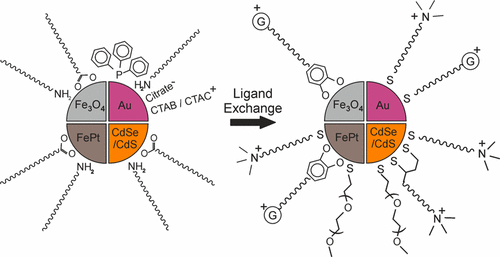当前位置:
X-MOL 学术
›
Chem. Mater.
›
论文详情
Our official English website, www.x-mol.net, welcomes your feedback! (Note: you will need to create a separate account there.)
Surface-Engineered Cationic Nanocrystals Stable in Biological Buffers and High Ionic Strength Solutions
Chemistry of Materials ( IF 8.6 ) Pub Date : 2017-11-01 00:00:00 , DOI: 10.1021/acs.chemmater.7b03504 Ryan M. Dragoman 1 , Marcel Grogg 2 , Maryna I. Bodnarchuk 1, 3 , Peter Tiefenboeck 4 , Donald Hilvert 2 , Dmitry N. Dirin 1 , Maksym V. Kovalenko 1, 3
Chemistry of Materials ( IF 8.6 ) Pub Date : 2017-11-01 00:00:00 , DOI: 10.1021/acs.chemmater.7b03504 Ryan M. Dragoman 1 , Marcel Grogg 2 , Maryna I. Bodnarchuk 1, 3 , Peter Tiefenboeck 4 , Donald Hilvert 2 , Dmitry N. Dirin 1 , Maksym V. Kovalenko 1, 3
Affiliation

|
Progress in colloidal synthesis in the last two decades has enabled high-quality semiconductor, plasmonic, and magnetic nanocrystals (NCs). As synthesized, these NCs are usually capped with long-chain apolar ligands. Postsynthetic surface functionalization is required for rendering such NCs colloidally stable in polar media such as water. However, unlike small anionic molecules and polymeric coatings, producing positively charged stable NCs, especially at high ionic strengths, has remained challenging. Here, we present a general approach to achieve aqueously stable cationic NCs using a set of small (<2.5 nm long) positively charged ligands. The applicability of this method is demonstrated for a variety of materials including semiconductor CdSe/CdS core/shell NCs, magnetic Fe@Fe3O4, Fe3O4, and FePt NCs, and three different classes of plasmonic Au NCs including large nanorods. The obtained cationic NCs typically have zeta potential values ranging from +30 to +60 mV and retain colloidal stability for days to months, depending on NC/ligand pair, in several biological buffers at elevated pH and in concentrated salt solutions. This allowed us to demonstrate site-specific staining of cellular structures using fluorescent cationic NCs with several different surface chemistries. Furthermore, colloidal stability of the obtained NCs in the presence of other charged species allowed the assembly of cationic and anionic counterparts driven primarily by electrostatic attraction. With this approach, we prepare highly uniform 3D and 2D binary mixtures of NCs through induced homogeneous aggregation and alternating-charge layer-by-layer deposition, respectively. Such binary mixtures may provide a new route in the engineering of nanocrystalline solids for electronics, thermoelectrics, and photovoltaics.
中文翻译:

在生物缓冲液和高离子强度溶液中稳定的表面工程阳离子纳米晶体
在过去的二十年中,胶体合成技术的进步使高质量的半导体,等离激元和磁性纳米晶体(NC)成为可能。合成后,这些NC通常被长链非极性配体封端。合成后的表面功能化是使此类NC在极性介质(例如水)中胶体稳定所必需的。但是,与小的阴离子分子和聚合物涂层不同,尤其是在高离子强度下,产生带正电荷的稳定NC仍然具有挑战性。在这里,我们提出了使用一组小的(<2.5 nm长)带正电荷的配体来实现水稳定的阳离子型NC的通用方法。证明了该方法对各种材料的适用性,包括半导体CdSe / CdS核/壳NC,磁性Fe @ Fe 3 O 4,Fe3 Ò 4,FePt NCs和三种不同类型的等离子Au NCs,包括大型纳米棒。所获得的阳离子NCs的zeta电位值通常在+30至+60 mV的范围内,并根据NC /配体对,在数种pH升高的生物缓冲液中以及在浓盐溶液中保持胶体稳定性数天至数月。这使我们能够证明使用具有几种不同表面化学性质的荧光阳离子NC可以对细胞结构进行定点染色。此外,所获得的NC在其他带电物质的存在下的胶体稳定性使得主要由静电吸引驱动的阳离子和阴离子对应物的组装成为可能。通过这种方法,我们通过诱导均匀聚集和逐层电荷交替沉积,制备了NC的高度均匀的3D和2D二元混合物,分别。这种二元混合物可能为电子,热电和光伏技术的纳米晶体固体工程提供一条新途径。
更新日期:2017-11-01
中文翻译:

在生物缓冲液和高离子强度溶液中稳定的表面工程阳离子纳米晶体
在过去的二十年中,胶体合成技术的进步使高质量的半导体,等离激元和磁性纳米晶体(NC)成为可能。合成后,这些NC通常被长链非极性配体封端。合成后的表面功能化是使此类NC在极性介质(例如水)中胶体稳定所必需的。但是,与小的阴离子分子和聚合物涂层不同,尤其是在高离子强度下,产生带正电荷的稳定NC仍然具有挑战性。在这里,我们提出了使用一组小的(<2.5 nm长)带正电荷的配体来实现水稳定的阳离子型NC的通用方法。证明了该方法对各种材料的适用性,包括半导体CdSe / CdS核/壳NC,磁性Fe @ Fe 3 O 4,Fe3 Ò 4,FePt NCs和三种不同类型的等离子Au NCs,包括大型纳米棒。所获得的阳离子NCs的zeta电位值通常在+30至+60 mV的范围内,并根据NC /配体对,在数种pH升高的生物缓冲液中以及在浓盐溶液中保持胶体稳定性数天至数月。这使我们能够证明使用具有几种不同表面化学性质的荧光阳离子NC可以对细胞结构进行定点染色。此外,所获得的NC在其他带电物质的存在下的胶体稳定性使得主要由静电吸引驱动的阳离子和阴离子对应物的组装成为可能。通过这种方法,我们通过诱导均匀聚集和逐层电荷交替沉积,制备了NC的高度均匀的3D和2D二元混合物,分别。这种二元混合物可能为电子,热电和光伏技术的纳米晶体固体工程提供一条新途径。



























 京公网安备 11010802027423号
京公网安备 11010802027423号